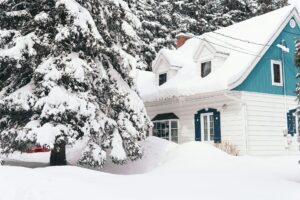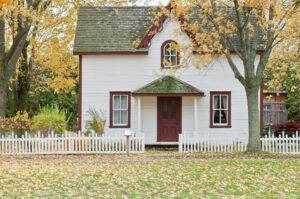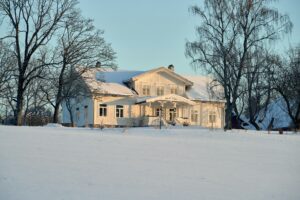Winter in Bend, Oregon, is brutal on roofs. Heavy snow loads, freeze-thaw cycles, and high winds put your roof through extreme stress every season. November is your critical window to assess whether your roof can survive another Central Oregon winter, or if it’s time for roof repair or complete roof replacement in Bend, OR. Catching problems now prevents emergency leaks, interior water damage, and costly mid-winter repairs. If you’ve been ignoring warning signs or your roof is approaching 15–20 years old, schedule a roof inspection with a local roofing contractor before the first snowfall hits.
How Bend’s Climate Affects Your Roof
Central Oregon’s climate creates roofing challenges that demand proactive roof maintenance in Bend, Oregon, and often accelerate the need for roof replacement. Understanding these stressors helps explain why even quality roofs fail faster here than in milder climates.
Snow Load and Structural Stress
Bend receives 20–30 inches of snow annually, with some winters delivering significantly more. According to NOAA climate data for Bend, heavy snowfall events can dump 12+ inches in 24 hours. A foot of wet, heavy snow weighs 10–20 pounds per square foot, placing serious stress on your roof structure.
Over time, repeated snow loads cause sagging, especially on aging roofs with compromised decking or trusses. Wind deposits snow unevenly, concentrating weight in valleys and lower-slope sections. If your roof shows any structural weakness, visible dips, soft spots when walking on it, or interior ceiling sagging, a roof inspection before winter is critical. Failure to address these issues can lead to catastrophic collapse under heavy snow accumulation.
Freeze-Thaw Cycles: Bend’s Silent Roof Killer
Bend’s notorious temperature swings, daytime highs above freezing, nighttime lows well below 32°F, wreak havoc on roofing materials. This freeze-thaw pattern occurs frequently between October and April, creating a destructive cycle:
- Daytime Melting: Sun warms roof surfaces, melting accumulated snow and ice. Water runs down and seeps into any existing cracks, gaps, or areas where shingles have lifted.
- Nighttime Freezing: Temperatures plummet after sunset. Water trapped in cracks freezes and expands, widening existing damage and lifting shingles further from the roof deck.
- Progressive Damage: Each cycle makes the problem worse. Small cracks become large gaps. Slightly lifted shingles become completely detached. Even quality architectural shingles degrade faster under these conditions than in stable climates.
A roof that looks fine during your October inspection can develop serious leaks by January without proper roof maintenance Bend Oregon homeowners schedule annually. This is why pre-winter roof inspection is essential, catching minor issues before freeze-thaw cycles turn them into major problems.
High Winds and Debris Damage
Central Oregon’s high-desert terrain channels powerful winds, especially during winter storms. Gusts regularly reach 30–50 mph, with stronger bursts during major weather events. These winds:
- Lift loose or aging shingles, tearing them off entirely or creating water entry points
- Propel debris like pine branches, cones, and tumbleweeds that impact and puncture roofing
- Stress flashing around chimneys, vents, and skylights, common leak points
- Expose underlayment when shingles are blown away, leaving your roof deck vulnerable
Combined with freeze-thaw damage, wind makes roof repair in Bend, OR a frequent necessity. If your neighborhood has mature ponderosa pines, fallen branches are an annual risk that can puncture even newer roofs.
Ice Dams and Interior Water Damage
Ice dams are one of Bend’s most destructive roofing problems. They form when heat escaping through a poorly insulated attic warms sections of the roof, melting snow unevenly. The process unfolds like this:
- Warm roof sections melt snow, creating water runoff
- Water flows toward colder eaves and gutters
- As water reaches the unheated roof edge, it refreezes
- Ice accumulates, forming a dam that blocks further drainage
- Meltwater pools behind the ice dam with nowhere to go
- Water is forced sideways and under shingles, seeping into your attic
The result? Water drips into attic insulation, ceilings, and walls, causing stains, mold growth, and structural rot. According to the University of Minnesota Extension’s ice dam research, even small ice dams can cause thousands of dollars in interior damage.
Proper roof installation with quality attic ventilation, adequate insulation (R-49 to R-60 for Central Oregon), and strategic ice-and-water shield placement prevents this costly damage. A local roofing contractor familiar with Bend’s climate knows exactly how to configure these elements for maximum protection.
Top Signs You Might Need Roof Repair or a New Roof
Recognizing warning signs helps you decide between repair and replacement, and avoid emergency calls during winter storms. Here are the critical indicators every Bend homeowner should watch for:
Missing, Cracked, or Curling Shingles
Shingles are your roof’s primary defense against weather. When they fail, everything beneath becomes vulnerable. Look for:
Missing Shingles: High winds commonly tear off loose or aging shingles, especially after storms. Even a few missing shingles create entry points for water that can damage underlayment, decking, and insulation. Check your roof and ground after windstorms, scattered shingles in your yard signal problems above.
Cracked Shingles: Bend’s freeze-thaw cycles and intense UV exposure make shingles brittle over time. Cracks allow moisture infiltration that worsens with every freeze cycle. A few cracks may warrant targeted roof repair, but dozens of cracked shingles indicate material failure across the system.
Curling Edges: When shingle edges curl upward or downward, it signals they’ve reached the end of their 15–25 year lifespan (depending on material quality). Curled shingles can’t seal properly, allowing wind-driven rain and snow underneath.
If you notice more than a handful of damaged shingles scattered across your roof, schedule a roof inspection with a local roofing contractor in Bend, OR. Isolated damage from a recent storm warrants roof repair. Widespread issues across multiple roof sections indicate the need for complete roof installation.
Active Leaks or Water Stains
Water intrusion is a serious red flag that demands immediate attention:
Attic Inspection: On a sunny day, go into your attic with the lights off. If you see pinpoints or streaks of daylight through the roof boards, you have gaps that will leak during rain or snowmelt. Also look for water stains on roof decking, dark streaks indicating moisture paths, or damp insulation.
Interior Ceiling Stains: Brown or yellow stains on ceilings, especially near chimneys, skylights, vents, or in valleys, indicate active or recent leaks. Don’t ignore small stains, they indicate water has already penetrated your roof system and is damaging materials behind your drywall.
Mold and Mildew: Persistent moisture from leaks creates ideal conditions for mold growth in attics and wall cavities. Mold compromises indoor air quality and requires costly remediation if left unchecked. Musty odors in upper-floor rooms or attic spaces often signal hidden moisture problems.
Even small leaks escalate quickly in Bend’s wet winter conditions. Prompt roof repair in Bend, OR prevents minor issues from becoming structural nightmares. A trusted roofer in Central Oregon can trace leak sources, which isn’t always directly above the visible stain, and recommend appropriate fixes.
Excessive Moss or Algae Growth
Bend’s pine-shaded neighborhoods and seasonal moisture create perfect conditions for moss and algae colonization:
Moisture Retention: Moss acts like a sponge, holding moisture against shingle surfaces and accelerating granule loss and material degradation. Shingles under heavy moss stay damp longer, promoting rot and reducing lifespan.
Root Penetration: Moss establishes root systems that work under shingle edges, physically lifting them and creating water entry channels. Once established, moss spreads rapidly across north-facing or shaded roof sections.
Aesthetic and Functional Decline: Heavy moss growth signals two problems: aging shingle materials losing their protective coatings (which resist biological growth), and neglected roof maintenance Bend Oregon residents should address regularly.
While professional moss treatment and zinc strip installation can extend your roof’s life temporarily, extensive moss coverage often indicates shingles are past their prime. At that point, roof replacement becomes the smarter long-term investment compared to repeated treatments on failing materials.
Sagging Roof Deck
A sagging roofline is never normal and indicates serious structural compromise:
Water Damage: Prolonged leaks saturate roof decking (plywood or OSB sheathing), causing it to soften, sag, and lose structural integrity. Walking on compromised decking feels spongy and unstable, extremely dangerous.
Snow Load Failure: Weak decking may fail catastrophically under heavy snow accumulation. If you notice any roof dip or sag, especially after heavy snowfall, evacuate that area and contact emergency roof services immediately.
Replacement Necessity: Compromised decking must be replaced during roof installation. This adds to project scope and cost but is absolutely essential for safety and long-term performance.
Never ignore a sagging roof. Contact a trusted roofer in Central Oregon immediately for an emergency roof inspection. This isn’t something that can wait for spring.
Granule Loss and Visible Wear
Asphalt shingles are coated with ceramic granules that protect against UV rays, weather, and fire:
Check Your Gutters: After heavy rain, inspect gutters and downspouts. A small amount of granule loss is normal on new roofs as loose manufacturing residue washes off. But if you’re finding cupfuls of granules regularly, or your gutters have thick granule sediment, your shingles are approaching end-of-life.
Bare Spots: Walk around your property and view your roof from different angles. Shingles with large bare patches where the black asphalt underlayer shows through have lost their protective coating. These areas deteriorate rapidly and are prone to leaks.
Age Factor: Granule loss accelerates in a roof’s final years, typically 15–20 years for standard 3-tab shingles and 20–30 years for higher-quality architectural shingles. If your roof is in this age range and showing significant granule loss, plan for a new roof rather than spending money on temporary fixes.
Daylight Through the Roof
This is one of the clearest danger signs: If you can see daylight through roof boards from inside your attic, you have holes or gaps in your roofing system. This means:
- Rain, snow, and wind-driven moisture enter freely
- Pests (birds, bats, squirrels, insects) have access to your attic
- Energy efficiency plummets as conditioned air escapes
- Insulation becomes saturated and ineffective
A single small gap might qualify for localized roof repair. Multiple gaps across different roof sections mean your roofing system has failed and roof replacement in Bend, OR is the only viable solution.
Why Work With a Local Roofing Contractor in Bend
Choosing a local roofing contractor Bend OR residents trust ensures you get specialized expertise and accountability that national chains can’t match.
Central Oregon Weather Expertise
Local roofers understand Bend’s snow loads, building codes, and which materials withstand freeze-thaw cycles, architectural shingles, metal roofing, or composites. They incorporate proper attic ventilation and insulation to prevent ice dams, delivering roofs that perform reliably through harsh winters.
Accountability and Material Knowledge
Local businesses are invested in community reputation. They’re accessible, responsive, and honor warranties for years. At HOMEMASTERS Bend, we build trust through quality craftsmanship and honest communication.
Local contractors know the best materials for Central Oregon:
- Asphalt architectural shingles (25–30 year warranties)
- Metal roofing (40–50+ year lifespan, excellent snow shedding)
- Composite shingles (engineered durability, fire resistance)
- Ice-and-water shield underlayment for vulnerable areas
Timely Scheduling
Bend’s weather window for roof installation is short. Local contractors prioritize fall scheduling before heavy snow makes work impossible. Familiarity with local suppliers and permitting means faster completion. When damage occurs, a local roofing contractor Bend OR homeowners know responds faster than distant companies.
Repair vs. Replace , What’s Best for Your Home?
Understanding when roof repair makes sense versus when roof replacement is smarter helps you budget wisely.
When Roof Repair Works
Minor, localized problems are repairable: a few missing shingles from windstorms, small flashing leaks, or isolated punctures. If your roof is under 10 years old and otherwise sound, targeted roof repair in Bend, OR extends life cost-effectively. Repairs buy time on tight budgets, though this is short-term if the roof is nearing end-of-life.
When Roof Replacement Makes Sense
- Age: Roofs 18–20+ years old (standard asphalt shingles) cost more to repeatedly repair than replace. A new roof offers decades of performance.
- Widespread Damage: When 30%+ of shingles are damaged or worn, full roof installation is more economical than piecemeal repairs.
- Structural Issues: Sagging decking, rot, or compromised trusses require addressing underlying structure during roof replacement.
- Energy Efficiency: Modern materials and improved ventilation/insulation reduce heating costs in Bend’s cold winters.
- Home Value: A new roof recoups 60–70% of cost at sale and attracts buyers.
Cost Comparison
| Project Type | Cost Range | Expected Benefit | Best Use |
|---|---|---|---|
| Minor Roof Repair | $300–$1,500 | 1–5 years added life | Isolated damage, young roof |
| Moderate Repair | $1,500–$4,000 | 3–7 years added life | Specific problems, mid-life roof |
| Full Roof Replacement | $8,000–$18,000+ | 20–50 years new life | Aged roof, structural issues |
At HOMEMASTERS, we provide honest assessments. Our roof inspection examines shingles, flashing, penetrations, attic leaks, ventilation, and structural integrity. We never upsell a new roof when roof repair serves you well, but we’ll recommend roof replacement when it’s the financially smart decision from a local roofing contractor Bend OR residents trust.
Common Questions About Roofing in Bend
How do I know if I need a new roof or repairs? Age is key. Roofs under 10 years with isolated damage usually need only roof repair in Bend, OR. Beyond 15–18 years or with widespread damage, roof replacement is more cost-effective. Schedule a professional roof inspection for a definitive answer.
What roofing materials work best for Central Oregon winters? Architectural asphalt shingles (25–30 year rated), metal roofing (40–50+ years), and composite shingles all handle Bend’s freeze-thaw cycles and snow loads. A local roofing contractor recommends the best fit for your home’s pitch, style, and budget.
How much does roof replacement cost in Bend? Expect $8,000–$18,000+ for average homes, depending on size, pitch, materials, and complexity. Costs include tear-off, underlayment, shingles or metal panels, flashing, ventilation, and disposal. Get multiple quotes for accurate estimates.
Can I install a new roof in winter? Not ideal. Roofing adhesives and shingles perform best in moderate temperatures. Ice, snow, and frozen materials make installation difficult and unsafe. Plan roof installation for late summer or fall for quality workmanship and full warranty coverage.
What’s the lifespan of metal vs. asphalt shingles? Metal roofing lasts 40–50+ years in Central Oregon. Standard asphalt shingles last 15–20 years; architectural shingles 25–30 years. Metal’s higher cost is offset by longevity and minimal maintenance.
Will a new roof reduce heating bills? Yes, when paired with attic insulation and ventilation upgrades. Addressing air leaks during roof installation reduces heat loss, lowering energy costs through Bend’s long winters.
Protect Your Home Before Winter Arrives
Central Oregon winters are unforgiving. Your roof is your first defense against snow, ice, wind, and freeze-thaw damage. Whether you need a roof inspection, targeted roof repair in Bend, OR, or complete roof replacement, taking action now, in November, prevents emergency leaks, costly interior damage, and mid-winter stress.
Don’t wait for the first major snowfall. Visit HOMEMASTERS Bend to schedule your roof inspection and honest estimate. We’re a local roofing contractor Bend OR residents rely on for expert craftsmanship, transparent pricing, and roofing built to handle Central Oregon’s toughest weather.
Schedule your roof inspection today and enjoy winter worry-free.




